Lawn Maintenance
Proper mowing and watering your lawn and other regular lawn maintenance tips.
Mowing:
Proper mowing is important for the appearance and health of your lawn.
Three important things to consider about lawn maintenance:
1. Mow at the correct height.
The hotter the weather, the higher you should mow.
Cutting your grass higher promotes deeper root development, prevents water loss, keeps the soil cooler and minimizes weeds and crabgrass. We cannot emphasize enough, the fact that mowing higher helps prevent crabgrass! As we have seen in side by side situations, lawns cut short are much more prone to crabgrass.
2. Mow often enough.
It is always best to avoid removing more than one third of the total grass plant leaf or blade during any single mowing. Mowing too short, or scalping, removes too much of the leaf surface exposing the brown stalks and stems of the plant.
It can take several weeks for your lawn to recover from a “scalping” and the stress placed on the plant will leave it vulnerable disease and insects.
3. Keep mower blades sharp.
Dull mower blades will leave the cut tips of the grass plant frayed or shredded causing a bleached, tan color and giving the lawn overall, an off color appearance.
4. Avoid mowing during extreme heat.
Watering:
Correct lawn maintenance will include watering. The summers can be extreme in the Chicago area. Our lawns are made up of cool season turf grasses and will decline in situations of extreme heat and drought.
Some basic concepts about watering are as follows:
1. Minimize water loss.
To minimize water loss to evaporation, avoid watering during the heat of the day.
Early morning is best because the surface will dry during the day helping to minimize disease.
2. Water deep enough.
Frequent shallow watering will cause a shallow root system that will not sustain your lawn through dry, hot periods. Therefore, it is best to water to a depth of 6 to 8 inches. One way to check for this is to push a screw driver or something similar into the soil. It should penetrate relatively easily for at least 6 inches. Once this is attained, allow the surface to dry out before the next watering.

